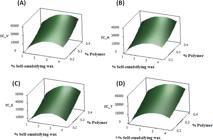Considering the importance of an adequate composition of the formulation in the development of stable, safe and effective cosmetic products, experimental design techniques are tools that can optimize the formulation development process. The objective of this study was to develop topical formulations using the Box-Behnken design with response surface methodology and evaluate its physical, sensory and moisturizing properties. The experimental design used in the first step allowed to identify and to quantify the influence of raw materials, as well as the interaction between them. In the second step, the analysis identified the influence of soy lecithin, the phytantriol and capric acid triglyceride and caprylic on the consistency index, stickiness and greasiness and skin hydration. Cetearyl alcohol, dicetyl phosphate and cetyl phosphate 10EO and acrylates/C10-30 alkylacrylate crosspolymer showed effects in rheological parameters. The addition of soy lecithin had significant effects in terms of consistency index, stickiness, oiliness and immediate moisturizing effects. Phytantriol showed effects on increasing consistency index and oiliness sensation. Thus, the experimental design was shown to be an effective tool for research and development of cosmetics, since it allowed the assessment of the individual and interaction effects of raw materials in the responses: rheological parameters, sensory and clinical efficacy.
Keywords:
Emulsions; Formulation; Stability; Skin barrier; Experimental design

 Thumbnail
Thumbnail
 Thumbnail
Thumbnail
 Thumbnail
Thumbnail
 Thumbnail
Thumbnail
 Thumbnail
Thumbnail
 Thumbnail
Thumbnail
 Thumbnail
Thumbnail
 Thumbnail
Thumbnail
 Thumbnail
Thumbnail








